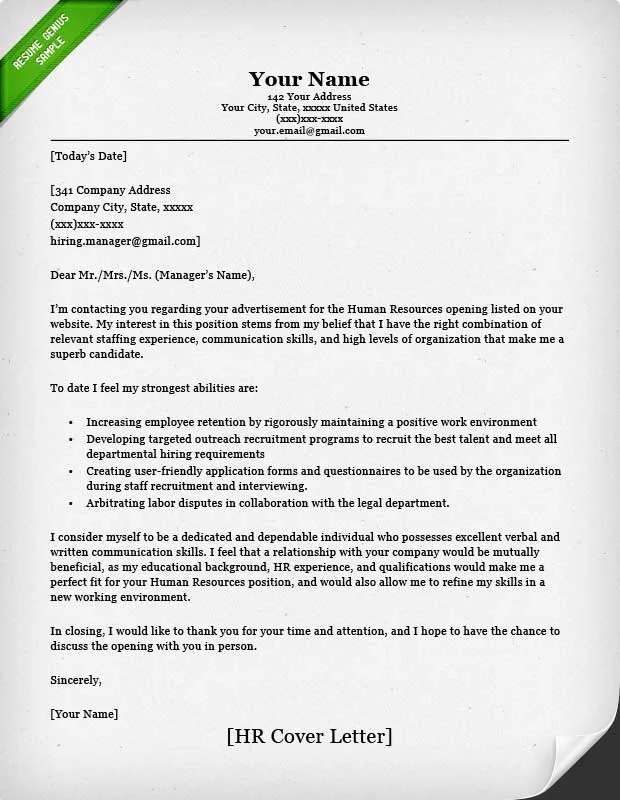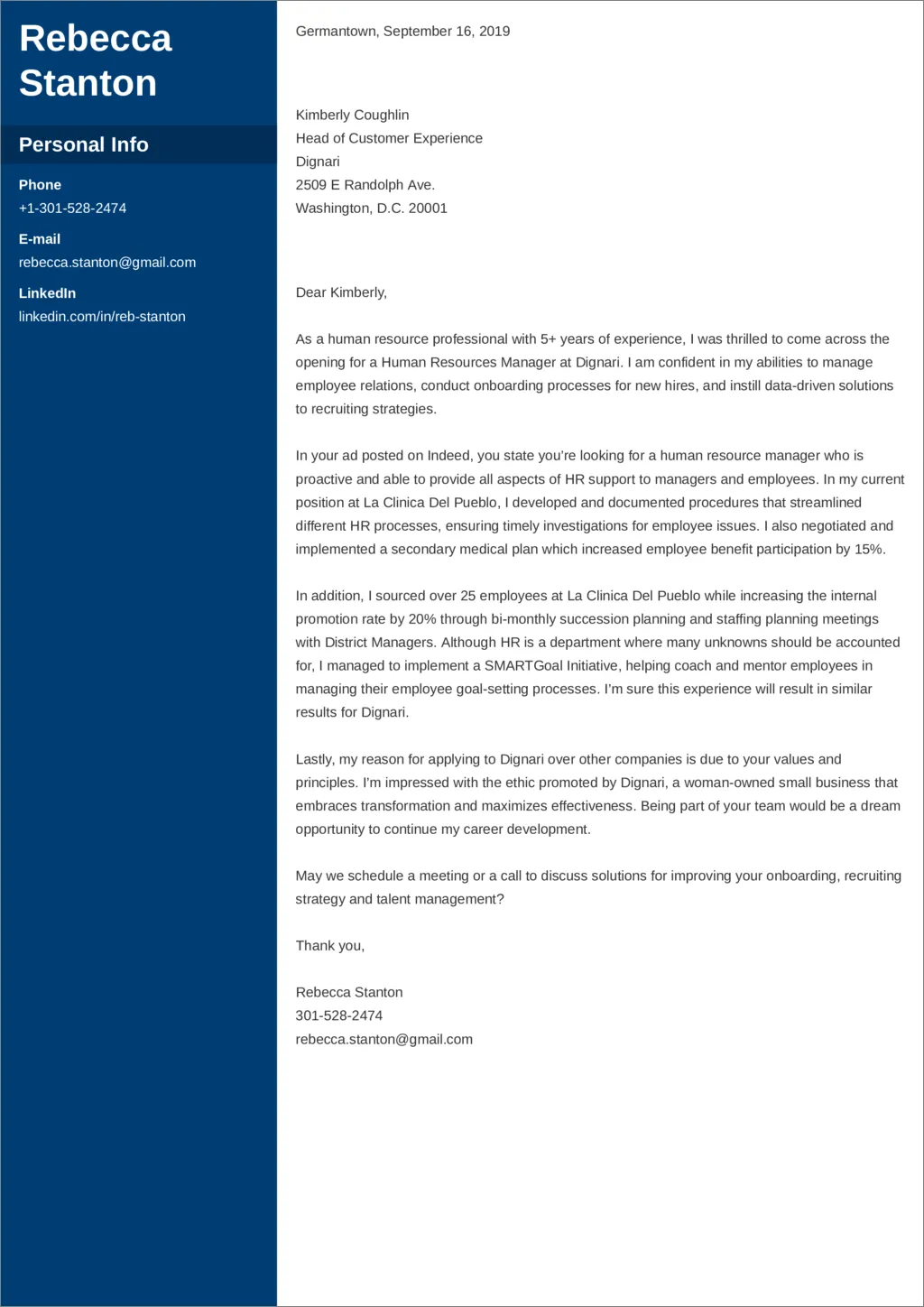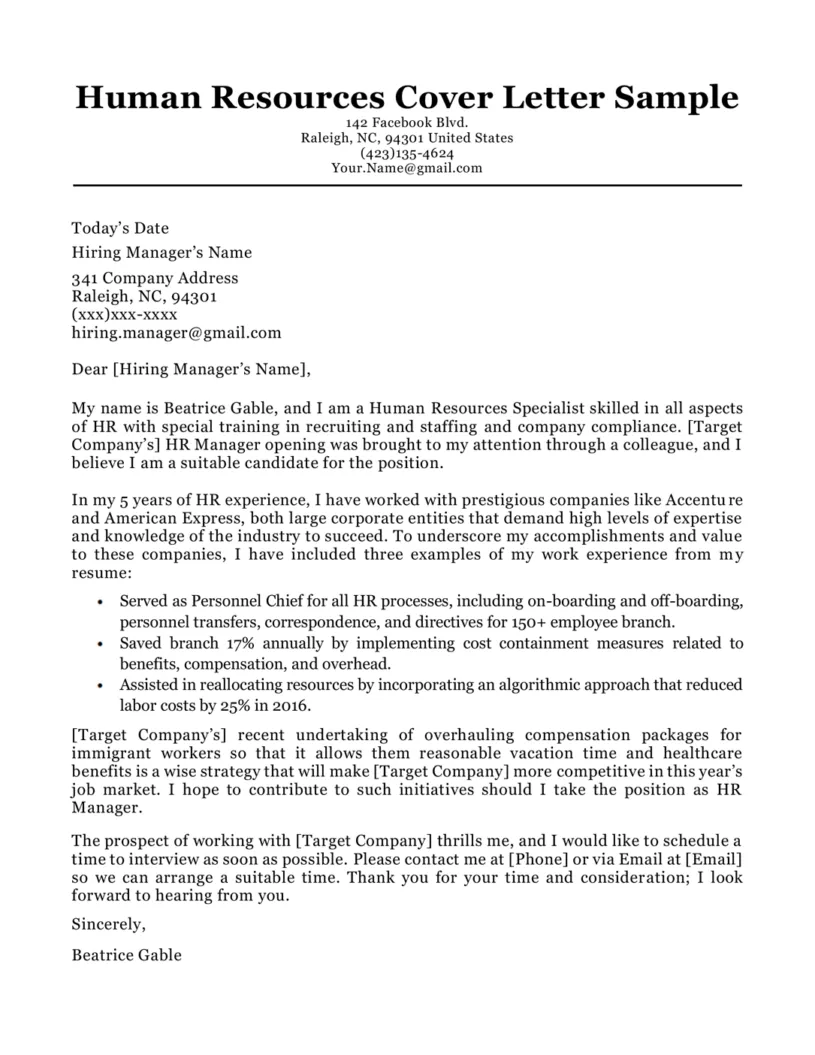Why a Human Resources Cover Letter Matters
In the competitive landscape of job applications, a well-crafted Human Resources (HR) cover letter is not just an optional add-on; it’s a crucial tool. It serves as your first formal introduction to a potential employer, allowing you to showcase your personality, skills, and enthusiasm beyond the confines of your resume. Think of your cover letter as your personal sales pitch, where you have the opportunity to elaborate on your qualifications and explain why you are the ideal candidate for the HR position. A strong cover letter immediately sets you apart from other applicants, demonstrating your professionalism, attention to detail, and commitment to securing the job. It also allows you to address any gaps in your resume or explain specific career choices.
Highlighting Your Human Resources Skills
Your cover letter is the perfect place to highlight the HR skills you’ve honed throughout your career. Start by identifying the core competencies essential for the specific role you are applying for. Common HR skills include recruitment and selection, employee relations, compensation and benefits, training and development, performance management, and HRIS systems. When describing your skills, provide specific examples of how you’ve utilized them to achieve positive outcomes. For instance, instead of just saying you’re good at recruitment, mention how you reduced time-to-hire by implementing a new sourcing strategy, or how you improved the quality of hires by implementing a structured interview process. Quantifiable results are always impressive. For example, state the percentage increase in employee retention you achieved through an improved employee engagement program.
Key Skills for Human Resources Professionals

Beyond technical skills, certain soft skills are invaluable in the HR field. These include strong communication skills (both written and verbal), active listening, empathy, problem-solving abilities, conflict resolution, and the capacity to build rapport. HR professionals often act as mediators, counselors, and confidantes, so excellent interpersonal skills are vital. Demonstrate how you’ve used these skills to build positive relationships with employees, mediate disputes, and create a supportive work environment. Mention any training or certifications you have in these areas, such as conflict resolution workshops or leadership programs. Additionally, HR professionals need to stay informed about current employment laws and regulations, so mention your knowledge of relevant compliance requirements, such as those pertaining to hiring, firing, and workplace safety.
Experience Section Human Resources Cover Letter
In the experience section of your cover letter, focus on demonstrating the relevance of your past roles to the specific HR position you are applying for. Do not merely list your job titles and responsibilities. Instead, provide concise, impactful statements that highlight your accomplishments and how they align with the employer’s needs. For each role, choose 2-3 key achievements that showcase your skills and expertise. Use action verbs to describe what you did and provide concrete examples of the results you achieved. If you improved employee engagement, mention the percentage increase. If you reduced turnover, specify the reduction rate. Also, customize this section to match the requirements outlined in the job description, emphasizing the experiences that directly relate to the position’s requirements. This tailored approach will demonstrate that you understand the role and are a good fit for the company culture.
Showcasing Achievements in Your Cover Letter
Achievements make your cover letter memorable and provide concrete evidence of your capabilities. Focus on the results you’ve delivered in your previous roles. Whenever possible, quantify your accomplishments using numbers, percentages, or specific metrics. For instance, instead of saying you improved the hiring process, say, “Streamlined the recruitment process, resulting in a 20% reduction in time-to-hire.” Describe the challenges you faced and how you overcame them. For example, if you implemented a new performance management system, explain the issues the company was facing beforehand, your specific actions, and the positive outcomes. Furthermore, link your achievements to the skills and qualities the employer is seeking. By showcasing your achievements, you prove you’re not just qualified but also capable of delivering results.
Tailoring Your Cover Letter to the Job

One of the biggest secrets to a successful HR cover letter is customization. A generic cover letter will rarely impress. Each cover letter should be tailored to the specific job and company. Begin by carefully reading the job description. Identify the key skills, experiences, and qualifications the employer is seeking. Then, use your cover letter to highlight how your background aligns with these requirements. This shows that you understand the role and have a genuine interest in the company. Research the company culture and values. Address the hiring manager by name if possible. Mention specific aspects of the company that attract you. Refer to the company’s website or recent press releases. Tailoring demonstrates your thoroughness and interest, which increases your chances of getting noticed.
Understanding the Job Description
The job description is your roadmap. Analyze it thoroughly to understand the employer’s expectations and priorities. Look for keywords related to skills, experience, and qualifications. Use these keywords throughout your cover letter, but do so naturally; avoid keyword stuffing. Break down the job description into its core components. Note the essential duties and responsibilities, as well as the desired qualifications. Then, structure your cover letter to address these components. Describe your relevant experiences and accomplishments that demonstrate you possess the required skills. Explain how your background aligns with the company’s needs and what you can bring to the role. Show how you can solve problems and make the team better. This approach demonstrates you understand the job and the employer’s needs.
Structuring Your Human Resources Cover Letter
A well-structured cover letter is easy to read and makes a positive first impression. Divide your letter into clear sections. Start with a compelling opening that grabs the reader’s attention and states your interest in the position. Then, elaborate on your skills and experiences, providing specific examples. Next, demonstrate your achievements and quantify them whenever possible. Finally, include a strong closing that reiterates your interest and prompts the reader to take action. Each paragraph should focus on a specific point. Use concise language and avoid jargon. Maintain a professional tone throughout. Proofread your cover letter carefully to eliminate errors. Consider using a template or format, but always personalize it to make it your own. A well-structured cover letter showcases your organizational skills and professionalism.
Crafting a Compelling Opening

The opening of your cover letter is critical; it sets the tone and determines whether the reader will continue. Instead of a generic opening, create an engaging hook. Mention how you learned about the job or the company. Highlight a specific achievement or skill that aligns with the job requirements. State the position you’re applying for. Express your enthusiasm and genuine interest in the role. Avoid clichés like “I am writing to apply for the position…” Instead, start with a strong, attention-grabbing sentence. For example, “With five years of experience in talent acquisition and a proven track record of reducing time-to-hire by 25%, I am excited to apply for the HR Specialist position at [Company Name].” Make sure the opening is tailored to the job. It should reflect your understanding of the company and the role, piquing the reader’s interest and making them want to read more.
Body Paragraphs for Human Resources
The body of your cover letter is where you showcase your skills, experience, and achievements. Each paragraph should focus on a specific aspect of your qualifications. Provide compelling examples of your accomplishments in previous roles. Use the STAR method (Situation, Task, Action, Result) to structure your responses, which helps you provide context. Describe the situation, the task you were assigned, the actions you took, and the positive results you achieved. Quantify your results whenever possible; use numbers or percentages to demonstrate the impact of your work. Link your skills and experiences to the requirements outlined in the job description. Show how your past experiences align with the company’s needs and demonstrate your ability to add value to the HR department. This structured approach helps to make your qualifications clear and compelling.
Closing Your Human Resources Cover Letter
The closing of your cover letter is your final opportunity to leave a lasting impression. Reiterate your interest in the position and the company. Summarize your key qualifications and skills, emphasizing how you align with the job requirements. Include a call to action, encouraging the reader to take the next step. Express your availability for an interview and thank the reader for their time and consideration. Always end with a professional closing, such as “Sincerely,” or “Best regards.” Proofread your entire cover letter, paying special attention to the closing. A well-crafted closing that is both enthusiastic and professional, encourages the reader to contact you, and ensures you will get the interview.
Actionable Steps and a Call to Action

Do not leave your application to chance; include a clear call to action to make it easier for the hiring manager to contact you. Express your eagerness to discuss your qualifications further. State your availability for an interview and provide your contact information. Encourage the reader to reach out to you to learn more about your experience. Make it easy for the employer to contact you. Ensure your contact details (email address, phone number, and LinkedIn profile) are up-to-date and prominent. A strong call to action shows your enthusiasm and initiative and significantly increases your chances of moving forward in the hiring process. By including a strong call to action, you move yourself closer to landing the interview.
Proofreading and Editing Your Cover Letter
Errors in your cover letter can significantly damage your chances of landing an interview. Proofreading and editing are essential steps in the application process. Always proofread your cover letter multiple times, checking for grammatical errors, spelling mistakes, and typos. Make sure your sentences are clear and concise. Read your cover letter aloud to catch any awkward phrasing or inconsistencies. Ask a friend, family member, or career advisor to review your cover letter. Consider using grammar-checking software or online tools to identify potential errors. Proofread all the details: company name, job title, and hiring manager’s name to ensure accuracy. A well-proofread and edited cover letter demonstrates attention to detail and professionalism, increasing your chances of making a positive impression.
Common Mistakes to Avoid
Certain common mistakes can undermine your cover letter. Avoid generic or boilerplate language, which will make your application seem uninspired and unprofessional. Do not exceed the suggested length. Keep your cover letter to one page unless specifically requested otherwise. Avoid exaggerating your qualifications or lying about your experience. Be truthful and accurate in all your statements. Don’t make negative comments about previous employers or colleagues. Instead, focus on your accomplishments and how you can contribute to the company’s success. Pay attention to formatting and presentation. Ensure your cover letter is easy to read, with clear headings, consistent fonts, and appropriate spacing. Avoid using excessive jargon or overly complex language. A clear, concise cover letter is always preferable.
Examples of Successful Human Resources Cover Letters

Analyzing examples of successful HR cover letters can provide valuable insights. Search online for samples of cover letters for HR positions. Pay attention to the structure, language, and tone used in these examples. Note how the candidates showcase their skills and experiences. See how they tailor their cover letters to specific job descriptions. Use these examples as a guide. Adapt the successful elements to create your own. Tailor it to your own background. Understand the specific requirements of the job. Remember that a customized cover letter, reflecting your unique skills and experiences, will always make a greater impression. Don’t copy directly from any sample. Rather, adapt the best practices to showcase your qualifications and personality.
